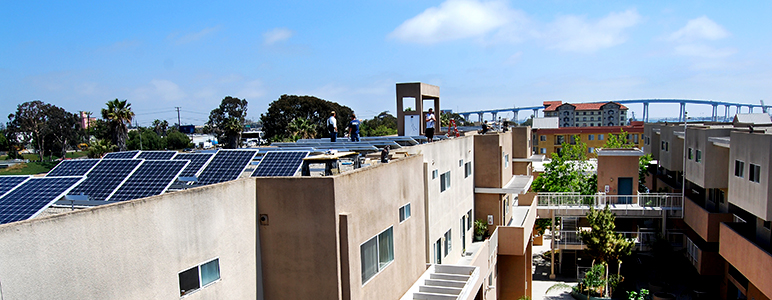


Seth Mullendore is a program manager at Clean Energy Group
The combination of solar PV and battery storage technologies is already reducing operating costs for businesses across California, but can solar+storage reduce electric bills for affordable housing as well? Based on new analysis, the answer is a resounding yes, to the point that electricity bills could be virtually eliminated in some cases.
These results are detailed in a new report, Closing the California Clean Energy Divide, which shows that pairing solar PV with battery storage systems can deliver significant electricity bill savings for affordable housing residents and property owners. Among the results, the analysis found that the addition of battery storage to a solar installation on affordable multifamily housing in California can nearly double the bill savings of solar-alone for about a third of the cost of the solar system.
“California has invested heavily to ensure qualified low-income properties have had equal access to our growing solar market. But recent changes to the critical underlying rates and tariffs may compromise the value proposition of solar for affordable housing residents and owners unless we find a way to include the combination of energy storage and solar in the Multifamily Affordable Housing Solar Roofs program.” - Sachu Constantine, CSE director of policy
Along with efficiency and solar PV, energy storage has emerged as an effective strategy for further reducing electricity costs for affordable housing. Because batteries empower PV owners to take control of the solar energy they produce and when they consume it, energy storage can both deliver an economic return on investment today and preserve the value of solar under future net metering policies and utility rate structures.
Hundreds of solar+storage systems have already been installed across the U.S., particularly in California. Unfortunately, few have been deployed to benefit low-income affordable housing communities. Many factors have contributed to this disparity, including a lack of information about the economics of these systems in multifamily rental housing.
To help fill this information gap, Clean Energy Group, California Housing Partnership, and Center for Sustainable Energy partnered with the energy software company Geli to analyze the economics of solar and battery storage in California affordable multifamily rental housing. California properties were chosen for this first-of-its-kind analysis due to the passage of California Assembly Bill 693, which authorizes the Multifamily Affordable Housing Solar Roofs program. The program allocates up to $1 billion in funding for deployment of solar system technologies in affordable multifamily rental housing over the next ten years, making it the largest program of its kind in the country.
The report details several key findings about the financial benefits of installing solar+storage in affordable multifamily rental housing in California.
FINDING 1 – Adding battery storage to an affordable rental housing solar installation in California can eliminate demand charges for building electricity loads, resulting in a net electricity bill of essentially zero.
A solar system designed to offset 100 percent of a building’s electricity consumption through net energy metering can reduce the energy usage charges on a property owner’s utility bill to zero, but these energy charges often amount to only about half of the total bill. For buildings that incur demand charges, which are based on the highest demand for power at any point over a billing period, the other half of the bill remains largely intact. Adding solar may result in a modest reduction in demand charge costs, but these savings are not guaranteed, as one cloudy day can erase savings for an entire period, and solar can do nothing to reduce peak demand occurring in early morning or evening hours.
Unlike solar, the addition of battery storage can reduce or even eliminate the remaining demand charges for affordable housing property owners. The analysis found that solar+storage deployed in certain buildings could lower electricity demand below a utility defined threshold, allowing property owners to switch to a utility rate structure with no demand charges.
As shown in the following figure, pairing battery storage with solar resulted in up to a $13,000 reduction in demand charge costs each year, leading to total annual electricity costs amounting to no more than about $100 in fixed charges.
Analysis results for nine affordable housing properties across California’s three investor-owned utilities: Pacific Gas & Electric (PGE1, PGE2, PGE3), Southern California Edison (SCE1, SCE2, SCE3), and San Diego Gas & Electric (SDG1, SDG2, SDG3). These utilities account for nearly 80 percent of California electric utility customers and encompass 70 percent of the state’s affordable housing rental properties and units. (Source: Clean Energy Group)
FINDING 2 – Adding battery storage to California affordable rental housing can almost double the building electricity bill savings achieved over the savings realized through solar along.
The economic analysis found that, in some cases, the addition of battery storage had the potential to almost double the utility bill savings that could be achieved by an affordable rental housing property owner over solar alone.
For example, as shown in the charts below, a building located within the Southern California Edison utility territory, identified as Building SCE3 in the report, saved $11,400 with solar and an additional $10,300 with the incorporation of battery storage, a 90 percent increase in savings over stand-alone solar. These additional savings from storage, while not directly lowering tenant electricity bills, can be passed through to affordable housing tenants or used to improve the property in other ways beneficial to residents, such as designing the solar+storage system to provide backup power in emergencies. The value proposition for tenants will likely improve with upcoming changes to California utility rate structures, such as time-of-use rates, and adjustments to net energy metering policies.
Source: Clean Energy Group
FINDING 3 – Adding battery storage can achieve incremental utility bill savings similar to solar for about a third of the cost of the solar system for owners of affordable rental housing properties in California.
The analysis found that the addition of battery storage to an affordable multifamily housing solar project can result in incremental savings essentially equal to those achieved through solar alone, while only increasing the installed cost of a project by about a third of the cost of the solar-only investment.
For example, in the analysis of a building in the San Diego Gas & Electric utility territory, Building SDG3, a $385,000 solar system was modeled to completely offset building electricity consumption. As shown in the figure below, this saved about $15,000 per year. Due to the batteries’ ability to manage demand below a specified threshold, adding a $112,100 battery storage system, at about a third the cost of the solar system, increased annual savings to $27,900. That amounts to an 85 percent increase in total savings for only a 29 percent increase in cost.
Installed cost of solar and battery storage systems to cover building common area loads (left axis) and the resulting annual electricity bill savings for the building (right axis). Project payback periods range from 4.7 to 8.6 years, noted above bars. Note that project payback periods factor in all available incentives, which are detailed in the report appendices. (Source: Clean Energy Group)
FINDING 4 – Solar+storage projects result in a significantly shorter payback period than stand-alone solar projects.
The analysis found that the payback period for stand-alone solar projects offsetting building electricity consumption ranged from 5.6 to 10.5 years, and 4.8 to 8.8 years for solar offsetting tenant electricity consumption.
While these time frames are well below the expected life of a solar project, incorporating battery storage into a project reduced the payback period of stand-alone solar in every building scenario analyzed. The payback reduction for property owners was quite significant in several cases. For the projects analyzed in this study, integrated solar+storage systems had a payback period of 4.7 to 8.6 years, shortening project payback by as much as 3.6 years and making for a much more favorable investment proposition.
The findings present a compelling case to include battery storage in the implementation of California’s Multifamily Affordable Housing Solar Roofs program. The addition of storage can enhance the investment value of this public funding and improve the resiliency and long-term financial stability of affordable housing assets in the state. Additionally, without battery storage, the value proposition for solar is vulnerable to looming shifts in solar policy and utility rate design, as has occurred in Nevada and Hawaii.
The report and supporting analysis lays the groundwork for consideration of battery storage in a solar incentive program, but more work needs to be done to inform the process. The organizations will be releasing two additional reports over the next several months to provide information that will address many of the remaining challenges, such as:
- Demonstrating how property owners can make a financially sound investment in solar+storage technologies
- Detailing how to structure an incentive program that provides for an integrated, inclusive mitigation package that includes efficiency, solar, and energy storage for the benefit of low-income tenants and owners of affordable rental housing properties alike
- Analyzing the case for the value of storage under likely future California solar policies and utility rate structures
While these reports and the Multifamily Affordable Housing Solar Roofs program are specific to California, successful design and implementation of the program could serve as a nation-wide model for deployment of solar and storage in affordable multifamily housing and help close the clean energy divide in the U.S.
Clean Energy Group will be hosting a webinar on Wednesday, June 15 to discuss the findings of this new report. Report authors from Clean Energy Group and the California Housing Partnership will present. The webinar, Reducing Electric Bills in California Multifamily Affordable Housing with Solar+Storage is free, but registration is required. This work builds upon the regional analysis of solar+storage in affordable housing that Clean Energy Group presented in a previous report, Resilience for Free, which outlines the continued need to provide policy support to advance these technologies for the benefit of low-income communities.

